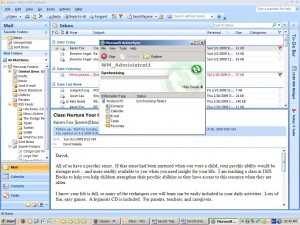by David Hakala
Compact, convenient smart phones are increasingly used in lieu of laptop computers for communication and personal information management when one is away from home or office. Consequently, it becomes necessary to ensure that up-to-date copies of your contacts, email, correspondence, and other frequently accessed information are on your phone as well as your desktop computer. You have to synchronize the two devices.
Microsoft’s ActiveSync v4.5 is a synchronization utility widely licensed by mobile device makers for use with smart phones based upon the Windows Mobile operating system. Vendors gussy it up with add-ons peculiar to their devices’ designs, but you can download the original at http://www.microsoft.com/windowsmobile/en-us/help/synchronize/activesync45.mspx
Why not just use the CD that came with your phone? Well, for instance, T-mobile added some “features” to ActiveSync’s installation routine that require the Flash viewer application. I have it installed but T-mobile’s buggy code doesn’t recognize that and so will not install ActiveSync. So I downloaded and installed the “vanilla” ActiveSync.
Note: Microsoft ActiveSync works only with Windows XP SP3 or earlier. If you have Windows Vista, your synchronization settings will be managed through the Windows Mobile Device Center. Windows Mobile Device Center is available through the Windows Mobile Device Center page: http://www.microsoft.com/windowsmobile/devicecenter.mspx
Once ActiveSync is installed and running, plug your mobile device into a USB port using the vendor’s provided USB cable, which may be proprietary. ActiveSync will detect the mobile device and begin synchronizing the items shown in the figure below.
The bad news: ActiveSync can be sidelined by a host of “known issues.” You would think that a simple serial communications link between phone and PC would be sufficient, but Microsoft made ActiveSync a TCP/IP application so it could work remotely with Exchange. Consequently, an ActiveSync session can be interrupted or blocked by firewalls, Internet connection managers, VPN clients, and other Internet applications. And you have to love this troubleshooting note from Microsoft:
“USB hubs and laptop docking stations have not exhibited consistent stability with Windows Mobile powered devices and ActiveSync.”
Sure, blame it on hardware makers instead of ActiveSync. It is highly recommended to connect your phone directly to a PC’s USB port and not through a hub or docking station.
If you encounter problems using ActiveSync, here is Microsoft’s troubleshooting page: http://www.microsoft.com/windowsmobile/en-us/help/synchronize/activesync-usb.mspx
David Hakala has perpetrated technology tutorials since 1988 in addition to committing tech journalism, documentation, Web sites, marketing collateral, and profitable prose in general. His complete rap sheet can be seen at


{ 2 comments }
So nice to understand
Wonderful site you have here but I was curious
about if you knew of any discussion boards that cover the same topics talked
about here? I’d really like to be a part of community
where I can get responses from other experienced people that share the same interest.
If you have any recommendations, please let
me know. Appreciate it!
Comments on this entry are closed.